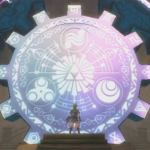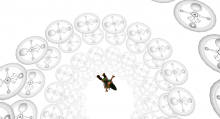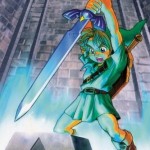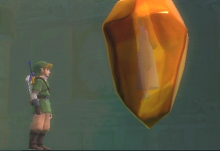Why the Zelda Series is Unsuccessful in Executing Time Travel
Posted on January 04 2014 by Legacy Staff
 One of the things for which the Zelda games are known is the creative design and gameplay of many of their titles. Probably the most famous twist of game design is their recurring utilization of time travel. Ocarina of Time, Majora’s Mask and Skyward Sword are all games which have incorporated time travel into their storylines. However, although these games are extremely popular, the fact still remains that along with the benefits and new ideas presented by this new mechanic, gaping holes in the game’s continuity arise with the introduction of this concept. Hit the jump to find out why!
One of the things for which the Zelda games are known is the creative design and gameplay of many of their titles. Probably the most famous twist of game design is their recurring utilization of time travel. Ocarina of Time, Majora’s Mask and Skyward Sword are all games which have incorporated time travel into their storylines. However, although these games are extremely popular, the fact still remains that along with the benefits and new ideas presented by this new mechanic, gaping holes in the game’s continuity arise with the introduction of this concept. Hit the jump to find out why!
Let’s begin with Majora’s Mask. This game is famous for its concept: the entire plot and gameplay revolving around the same three-day cycle. Overall, the details of the game are very secure and accurate. The plot and characters function well, no matter what you do during the three days. Because the time period is so short, the list of possible outcomes of Link’s actions is simplistic and manageable.
 But it’s not the storyline that bothers me about the time travel in this game. It’s the little things. When you play the Song of Time and return to the dawn of the first day, you lose all of your ‘numerical items.’ The total of your rupees, bombs, arrows and Deku nuts drops to zero, no matter how many you had when you first entered Clock Town as a Deku Scrub. This in itself presents several problems. During the tutorial, there is ample opportunity for you to gain rupees and Deku nuts and to lose hearts before you enter the three-day cycle. If you were really being taken back to the exact point at which you arrived in Clock Town (the break of dawn), your rupees should only go down to the number which you had at that point. Your hearts, magic meter and Deku nuts should be affected in the same way. By this logic, you should also be transformed into a Deku Scrub again, considering that’s how you appeared at the dawn of the first day. It is, however, appropriate that you are left with no bombs or arrows, considering you didn’t have them when you first entered Clock Town, which brings me to my next point.
But it’s not the storyline that bothers me about the time travel in this game. It’s the little things. When you play the Song of Time and return to the dawn of the first day, you lose all of your ‘numerical items.’ The total of your rupees, bombs, arrows and Deku nuts drops to zero, no matter how many you had when you first entered Clock Town as a Deku Scrub. This in itself presents several problems. During the tutorial, there is ample opportunity for you to gain rupees and Deku nuts and to lose hearts before you enter the three-day cycle. If you were really being taken back to the exact point at which you arrived in Clock Town (the break of dawn), your rupees should only go down to the number which you had at that point. Your hearts, magic meter and Deku nuts should be affected in the same way. By this logic, you should also be transformed into a Deku Scrub again, considering that’s how you appeared at the dawn of the first day. It is, however, appropriate that you are left with no bombs or arrows, considering you didn’t have them when you first entered Clock Town, which brings me to my next point.
If you had attained a special item or mask during your previous cycle, the game graciously lets you keep it after you save. While it would be frustrating and game-breaking to lose it, keeping your item makes no sense whatsoever. Link certainly didn’t have it when he arrived in Clock Town. So, while everything else is set back, even draining Link of his rupees, he somehow gets to keep his one-of-a-kind item for no apparent reason. If his rupees and bombs are drained to zero, shouldn’t Link lose everything else too? While this trick is confusing and logically impossible, Link doesn’t seem to be the only one who can utilize it.
One character who has puzzled gamers for years is the banker in West Clock Town. When you first go up to him, he puts a stamp on your head which will remind him of who you are and how much you have in your account. He will hold onto your rupees for you, taking good care of them, even preserving them from time. If Link loses the rupees in his wallet, it would only make sense for them to disappear out of the bank as well. Yet, somehow, they are always there, ready to pick up any time you need them.
But Majora’s Mask isn’t the only game which messes up time travel. Ocarina of Time also has some shady areas in respect to this aspect of the game design. The first problem is a small one, but still deserves mention. Upon the retrieval of the Master Sword, Link becomes able to switch between his life as a child and his life as an adult at will. So, Link is able to become an adult, change to being a child, complete a few sidequests, and return to his adult form. While this appears harmless and clear of any technical issues, Link’s varying actions call into play the Butterfly Effect.
isn’t the only game which messes up time travel. Ocarina of Time also has some shady areas in respect to this aspect of the game design. The first problem is a small one, but still deserves mention. Upon the retrieval of the Master Sword, Link becomes able to switch between his life as a child and his life as an adult at will. So, Link is able to become an adult, change to being a child, complete a few sidequests, and return to his adult form. While this appears harmless and clear of any technical issues, Link’s varying actions call into play the Butterfly Effect.
The Butterfly Effect describes the scenario in which, when initial circumstances are changed slightly, the long-term effects differ greatly. Simply put, if Link collects a few skull tokens in the past, it might dramatically affect his future. Even if the results aren’t very drastic at all, some change ought to have occurred by at least one of Link’s actions as a child. But, no matter what you do, Link’s experience as an adult remains exactly the same, with the exception of the sidequest at Lon Lon ranch.
The final game that I have found which has problems due to poorly handled time travel is Skyward Sword. The most obvious form of time travel in this game is the utilization of Timeshift Stones. However, the use of these stones is actually pretty smooth (excepting the fact that going back in time would cause Link to disappear, considering that he hadn’t been born in that era), and it is without question one of my favourite gameplay mechanics in the entire series. Of course, with a concept that prominent, the proper attentions are bound to be paid to it to ensure that problems don’t arise. That’s why the snags arise with a feature that is a bit more subtle.
 I find the Gate of Time to be extremely problematic as far as technicalities go. First, consider Zelda’s quest. She descends to the surface and begins to pray at each bird statue, until she has regained the memories of her former life. She then goes into the Gate of Time, delivers a heart-wrenching speech, then, much to Link’s dismay, seals herself away in an amber crystal in order to prevent the revival of Demise. The only problem with this is that she remains in the crystal until the end of the game, when Link finally frees her. This means that, while Zelda is initially running around, praying to the bird statues, she rests, dormant in her seal at the very same time. You can even peek through the decrepit doors of the Sealed Temple and see her there. Last I checked, there was only one Zelda.
I find the Gate of Time to be extremely problematic as far as technicalities go. First, consider Zelda’s quest. She descends to the surface and begins to pray at each bird statue, until she has regained the memories of her former life. She then goes into the Gate of Time, delivers a heart-wrenching speech, then, much to Link’s dismay, seals herself away in an amber crystal in order to prevent the revival of Demise. The only problem with this is that she remains in the crystal until the end of the game, when Link finally frees her. This means that, while Zelda is initially running around, praying to the bird statues, she rests, dormant in her seal at the very same time. You can even peek through the decrepit doors of the Sealed Temple and see her there. Last I checked, there was only one Zelda.
Another character who is affected by the difficulties of the Gate of Time is Impa. When you first meet her, she is an extremely elderly lady, waiting with immeasurable patience for the foretold hero to arrive. Later in the game, the young Impa is called by the goddess to pass though the Gate in order to assist Zelda in her journey. When you see Impa in her youth after the completion of the Lanayru Mining Facility, she tells you go to back to the lady in the Sealed Grounds, referencing herself. At that very moment, two Impas exist in that time period, both the old and the young. Granted, the youthful Impa proceeds to go back to her time period, taking Zelda with her, but through the second and third dungeons of the game, two Zeldas and two Impas exist in the present time.
I find all these breaks in continuity to be very disappointing. Unearthing flaws in anything which you enjoy always is. But, in the long run, what does it really matter? Since when has the series not had weird logic? A few problems in the execution of a story mechanic are no less reasonable than being able to barge into people’s houses, break their things, jump on their tables, steal their money and leave in the highest state of popularity.
Also, while many of the details surrounding time travel in the games are illogical, it is often much better for the flow of the gameplay than if they made sense. Imagine the frustration that we would have if a seemingly insignificant action in the child portion of Ocarina of Time caused some sidequests in the adult portion to be impossible to complete. So, while the Zelda games may be unable to successfully execute time travel, in some cases, it’s a good thing that they can’t.
What do you think? Is it excusable for the Zelda games to employ messy gameplay mechanics? What would you do better in order to fix these problems. Let me know your opinion in the comments below.



